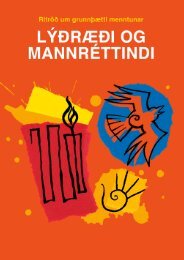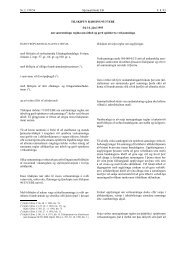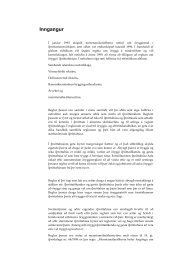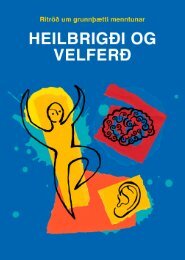Arts and Cultural Education in Iceland : Professor Anne Bamford
Arts and Cultural Education in Iceland : Professor Anne Bamford
Arts and Cultural Education in Iceland : Professor Anne Bamford
You also want an ePaper? Increase the reach of your titles
YUMPU automatically turns print PDFs into web optimized ePapers that Google loves.
Some arts schools are emerg<strong>in</strong>g from strong local dem<strong>and</strong> <strong>and</strong> be<strong>in</strong>g developed through<br />
volunteer support <strong>and</strong> private philanthropic fund<strong>in</strong>g at the local level, as the follow<strong>in</strong>g example<br />
shows:<br />
The school pays for one art teachers (pa<strong>in</strong>ter). The drama department is run by volunteers. The school is more<br />
or less <strong>in</strong>dependently run – with an agreement between them – under the name of the Art School. The school<br />
directors (or heads of each division) meet once a month <strong>and</strong> plan jo<strong>in</strong>t projects. This spr<strong>in</strong>g we were go<strong>in</strong>g to do<br />
a musical which will have to be postponed until next year because of the poor economy. The school has been<br />
gett<strong>in</strong>g support from banks <strong>and</strong> other big companies; perhaps 500.000 ISK annually from each bank or company.<br />
Production like a musical would cost between 4-5 million <strong>in</strong> total <strong>and</strong> would end with a public show, free for the<br />
public. Dur<strong>in</strong>g the last week of February we go out <strong>in</strong> the community <strong>and</strong> play for people – the old people's<br />
home, the public schools, homes for the disabled, etc. Dance is not yet offered <strong>in</strong> the school, but hopefully we'll<br />
have that soon. Next year a new secondary school will be built <strong>in</strong> the community with emphasis on the arts, out<br />
doors, nature, literature <strong>and</strong> sports.<br />
The pattern of <strong>in</strong>struction <strong>in</strong> the private arts schools varies considerably. Some visual arts<br />
schools focus on learn<strong>in</strong>g formal techniques, crafts <strong>and</strong> produc<strong>in</strong>g works for exhibition. Other art<br />
schools offer a range of visual arts experiences <strong>in</strong>clud<strong>in</strong>g film mak<strong>in</strong>g, draw<strong>in</strong>g, pa<strong>in</strong>t<strong>in</strong>g <strong>and</strong><br />
sculpture. Jewellery mak<strong>in</strong>g <strong>and</strong> ceramics may be offered. Craft may also be available, especially<br />
textile. The range of offer<strong>in</strong>gs often depends on the <strong>in</strong>terests <strong>in</strong> the community <strong>and</strong> the skills of<br />
the available teachers <strong>and</strong> volunteers. Where dance is taught, it is primarily classical ballet or<br />
jazz ballet. Some schools have tried to <strong>in</strong>troduce folk danc<strong>in</strong>g or ballroom danc<strong>in</strong>g. Drama<br />
schools are often closely l<strong>in</strong>ked to amateur theatre <strong>and</strong> prepare plays, musicals <strong>and</strong> pieces for<br />
performances. The arts schools often have classes of mixed ages, <strong>in</strong>clud<strong>in</strong>g adults.<br />
This quote 15 from the pr<strong>in</strong>cipal of Icel<strong>and</strong>’s major art academy <strong>in</strong> 2005 po<strong>in</strong>ts to the<br />
differences <strong>in</strong> availability between music <strong>in</strong>stitutions <strong>and</strong> those cater<strong>in</strong>g for other art forms:<br />
The visual art schools are not as numerous as the music schools. Most of them be<strong>in</strong>g “course-schools” that<br />
provide courses for children <strong>and</strong> adults alike. Myndlistarskól<strong>in</strong>n á Akureyri is notable as it def<strong>in</strong>es itself, for the<br />
most part, as an undergraduate <strong>in</strong>stitution. Myndlistarskól<strong>in</strong>n í Reykjavík (‘The Reykjavík School of Visual <strong>Arts</strong>’) is<br />
an all-round school that runs a robust foundation programme prepar<strong>in</strong>g for undergraduate studies. Both schools<br />
receive f<strong>in</strong>ancial support from the state <strong>and</strong> their respective city councils. One film school operates <strong>in</strong> Icel<strong>and</strong>,<br />
Kvikmyndaskóli Ísl<strong>and</strong>s. The school’s ma<strong>in</strong> source of <strong>in</strong>come is from tuition. The school is privately run <strong>and</strong><br />
operates <strong>in</strong> l<strong>in</strong>e with the upper secondary level national curriculum. Listdansskóli Ísl<strong>and</strong>s is the only special art<br />
school that is still directly operated by the state. The school offers both primary <strong>and</strong> secondary education.<br />
Former students of the school now form the core of dancers <strong>and</strong> dance-artists responsible for the contemporary<br />
dance scene <strong>in</strong> Icel<strong>and</strong>. Theatre arts have been left out. There is no comprehensive foundation programme <strong>in</strong> the<br />
field – despite of repeated attempts to put right.<br />
Many of the arts schools have emerged from `grassroots` <strong>in</strong>itiatives, but have gone on to<br />
have strong support <strong>in</strong> the community <strong>and</strong> offer <strong>in</strong>terest<strong>in</strong>g <strong>and</strong> extensive programmes. Some<br />
manage to become entrenched <strong>and</strong> are able to then leverage some level of public fund<strong>in</strong>g, as<br />
the follow<strong>in</strong>g example shows:<br />
Vignette 1.13.1 We offer someth<strong>in</strong>g that everyone<br />
I ran a gallery <strong>in</strong> another house. I started then to do some art lessons – pa<strong>in</strong>t<strong>in</strong>g <strong>and</strong> draw<strong>in</strong>g. Then we moved <strong>in</strong> to a<br />
bigger house <strong>in</strong> 1991. We began <strong>in</strong>troduc<strong>in</strong>g other art forms. We started with more arts experiences, like pottery.<br />
Then we <strong>in</strong>troduced music <strong>and</strong> drama. My husb<strong>and</strong> is a music teacher. Form there we added <strong>in</strong> ballet.<br />
We get teachers com<strong>in</strong>g to work here from all over the world. A lot of our teachers come from F<strong>in</strong>l<strong>and</strong>, Denmark <strong>and</strong><br />
Pol<strong>and</strong>. We sent our teachers <strong>and</strong> some of the ballet pupils to F<strong>in</strong>l<strong>and</strong> for three weeks. There were no local teachers<br />
because Icel<strong>and</strong>ic teachers don’t want to leave Reykjavik. The F<strong>in</strong>nish teachers are excellent. I th<strong>in</strong>k arts education is<br />
very good <strong>in</strong> F<strong>in</strong>l<strong>and</strong>. They are quite amaz<strong>in</strong>g too. They learn Icel<strong>and</strong>ic <strong>in</strong> only 3 or 4 weeks.<br />
15 Hjálmar H. Ragnarsson: Menntaskóli listanna (‘College of the <strong>Arts</strong>’) the pr<strong>in</strong>cipal director of the Icel<strong>and</strong>ic Academy of the<br />
<strong>Arts</strong>. Published <strong>in</strong> Morgunbladid October 2005, page 3.<br />
46


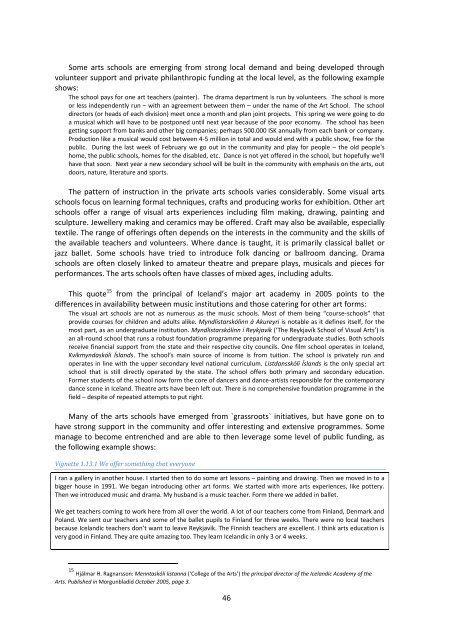
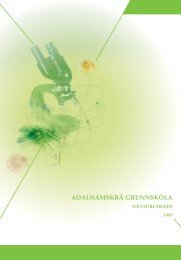
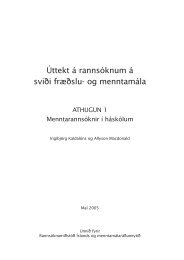

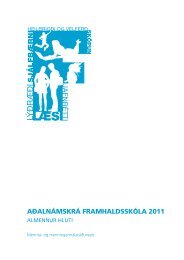
![Aðalnámskrá tónlistarskóla : rytmÃsk tónlist [Eingöngu á rafrænu formi]](https://img.yumpu.com/50843672/1/184x260/aaalnamskra-tanlistarskala-rytma-sk-tanlist-eingangu-a-rafranu-formi.jpg?quality=85)
